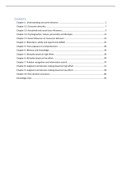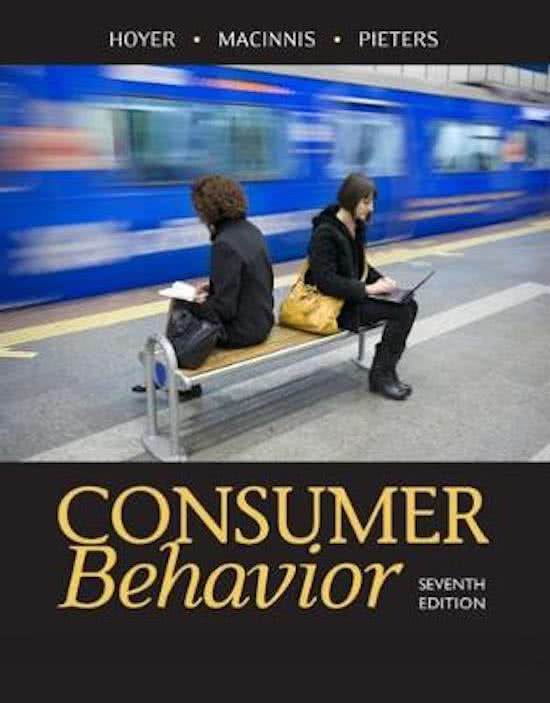Contents
Chapter 1: Understanding consumer behavior: .................................................................................. 2
Chapter 12: Consumer diversity: ......................................................................................................... 7
Chapter 13: Household and social class influences:............................................................................ 9
Chapter 14: Psychographics: Values, personality and lifestyles: ...................................................... 13
Chapter 11: Social influences on Consumer behavior: ..................................................................... 19
Chapter 2: Motivation, ability and opportunity (MAO) .................................................................... 25
Chapter 3: From exposure to comprehension: ................................................................................. 30
Chapter 4: Memory and knowledge:................................................................................................. 34
Chapter 5: Attitudes based on high effort: ....................................................................................... 39
Chapter 6: Attitudes based on low effort: ........................................................................................ 44
Chapter 7: Problem recognition and information search: ................................................................ 47
Chapter 8: Judgment and decision making based on high effort: .................................................... 51
Chapter 9: Judgment and decision making based on low effort:...................................................... 58
Chapter 10: Post-decision processes:................................................................................................ 60
Knowledge clips: ................................................................................................................................ 64
,Chapter 1: Understanding consumer behavior:
Consumer behavior: totality of consumers’ decisions with respect to the acquisition, consumption,
and disposition of goods, services, activities, experiences, people, and ideas by (human) decision-
making units.
Because consumer behavior means more than the way a person buys products. It also includes the
consumption of so many things (activities like going to the dentist F.I.) the term offering is being used
to encompass these entities.
Offering: a product, service, activity, experience, or idea offered by a marketing organization to
consumers.
What is consumer behavior?
Consumer behavior includes more than only buying a single tangible product.
Acquiring an Offering:
Acquiring: process by which a consumer comes to own an offering.
Buying is just one thing of acquiring an offering it consists of:
- Buying: common acquisition for many offerings.
- Trading: receive a good or service as part of a trade.
- Renting/leasing: renting or leasing instead of buying.
- Bartering: exchange goods/services without having money change hands.
- Gifting: gift-giving occasions informal or formal.
- Finding: find lost goods.
- Stealing: theft of an offering.
- Sharing: Lending an offering without losing the property rights.
Using an offering:
Usage: process by which a consumer uses an offering.
,It is the very core of consumer behavior.
Disposing of an offering:
Disposition: process by which a consumer discards an offering.
Consumers who want to dispose of a tangible product have several options:
- Find a new use for it: using an old toothbrush to clean rust from tools or making shorts out
of an old pair of jeans. Using an item for something different instead of disposing it.
- Get rid of it temporarily: renting or lending an item.
- Get rid of it permanently: throwing away, sending it away, trading, selling.
Consumer behavior a dynamic process:
Sequence of acquisition, consumption and disposition can occur over time in a dynamic order (hours,
days, weeks, months, or years). Consumer behavior is also changing over time. Fifty years ago,
consumers had far fewer brand choices and were exposed to fewer marketing messages, while today
consumers are more connected, easily able to research online and access to communications and can
check what others think.
Consumer behavior can involve many people:
Consumer behavior does not reflect to actions of a single individual. A group of people can also
decide together. Individuals in the group can take one or multiple roles.
Consumer behavior involves many decisions:
1. Whether to acquire/use/dispose of an offering? Decide to spend/save money, how much to
spend. Self-control is an important factor in these.
2. What offering to Acquire/use/dispose? Decisions about what to buy: decisions about
product or service categories, choosing between brands.
3. Why acquire/use/dispose of an Offering? Many reasons, important is that it meets
someone’s needs, values, or goals.
4. Why is an offering not acquired/used/disposed of? Marketeers try to understand why
consumers do not buy an offering.
5. How to acquire/use/dispose of an offering? How do consumers acquire/use/dispose an
offering?
6. When to acquire/use/dispose of an offering: timing of consumer behavior, depends on
many factors.
7. Where to acquire/use/dispose of an offering? Decisions about where to consume various
products.
8. How much, often, and how long to acquire/use/dispose of an offering? Decide how much
you need, how often they need it and how much time they will spend in acquisition, usage,
and disposition.
Consumer behavior involves emotions and coping:
Emotions can affect how consumers think, the choices they make, how they feel after a decision,
what they remember and how much they enjoy.
What is affecting consumer behavior?
There are four broad domains that affect acquisition, usage, and disposition decisions:
- The psychological core
- The process of making decisions
- The consumer’s culture
- Consumer behavior outcomes.
Although the domains are being named separate, they are related to all the others.
, 1. The psychological core (internal consumer processes)
Before making decisions consumers need some source of knowledge or information to base their
decisions on. This source covers:
- Motivation, ability, and opportunity (MAO): Motivation is about how motivated you are to
learn something to find out information. Ability is about the skills that you’ve got, and the
opportunity needs to be there to carry out your motivation and ability.
- Exposure, attention, perception, and comprehension (EAPC): When there is MAO you will
make sure to get exposed to relevant information that is relevant for your consumer
decision. But you cannot attend to all the relevant information. The perception is about
identifying what needs to be perceived. And the last thing is to comprehend the information
to decide.
- Memory and knowledge: About storing and recalling information. Depends on MAO and
choices are being made based on information that can be retrieved from memory.
- Attitudes: forming attitudes towards something.
2. The process of making decisions:
There are four stages of making decisions and they are intimately tied to the process of making
decisions:
1. Problem recognition: when there is an unfulfilled need. Once there is a realization of a
problem recognition the start of information search begins.
2. Information search: being exposed to information, attending, and perceiving it, categorizes
and comprehend it and forming attitudes towards the memory.
3. Decision-making:
a. High-effort decisions: willingness to invest time, mental/emotional energy.
b. Low-effort decisions: The other way around, not willing to invest time and
mental/emotional energy towards a decision.
4. Post purchase evaluation: judge whether the decision was correct and if they are
repurchasing the same thing again.
3. The consumer’s culture (external process): consumption decisions and how we process
information are affected by culture in a large part.
Culture: typical or expected behaviors, norms, and ideas that characterize a group of people.
It can influence all aspects of human behavior.
Reference groups and other social influences:
Reference groups: group of people consumers compare themselves with for information regarding
behavior, attitudes, or values.
You might want to emulate the behavior of people who you see a similar.
Diversity influence:
Member of regional, ethnic, religious groups that directly or indirectly affect decisions that you make.
Household and social class influences:
Whenever you are member of a social class might influence your decisions. Also, your household can
be able to do so.
Values, personality, and lifestyle:
Choices that are being made are part of beliefs, personality, activities, interests, and opinions.






